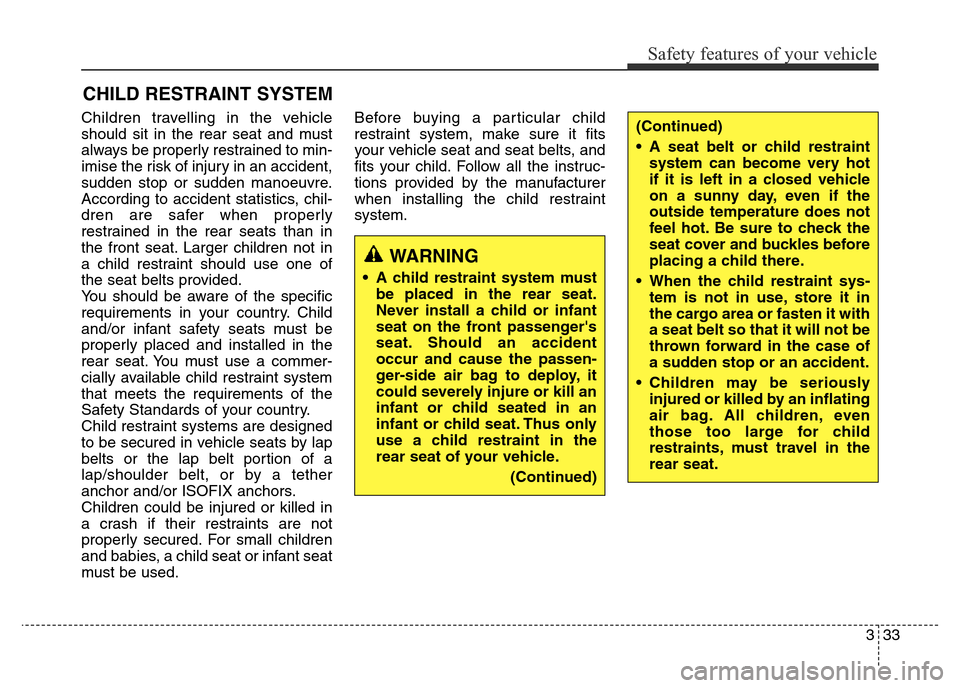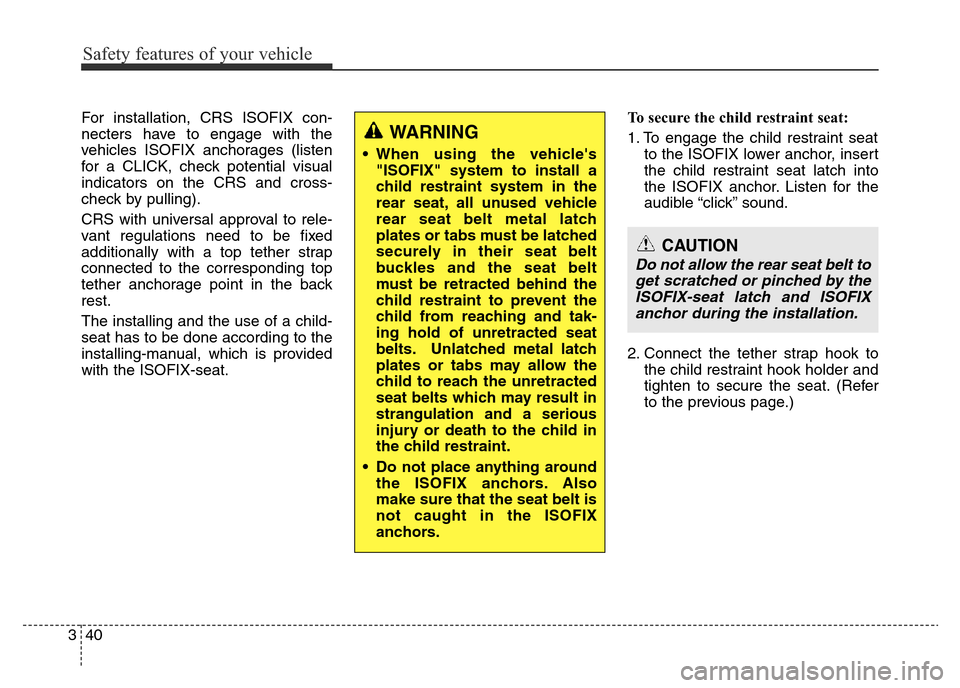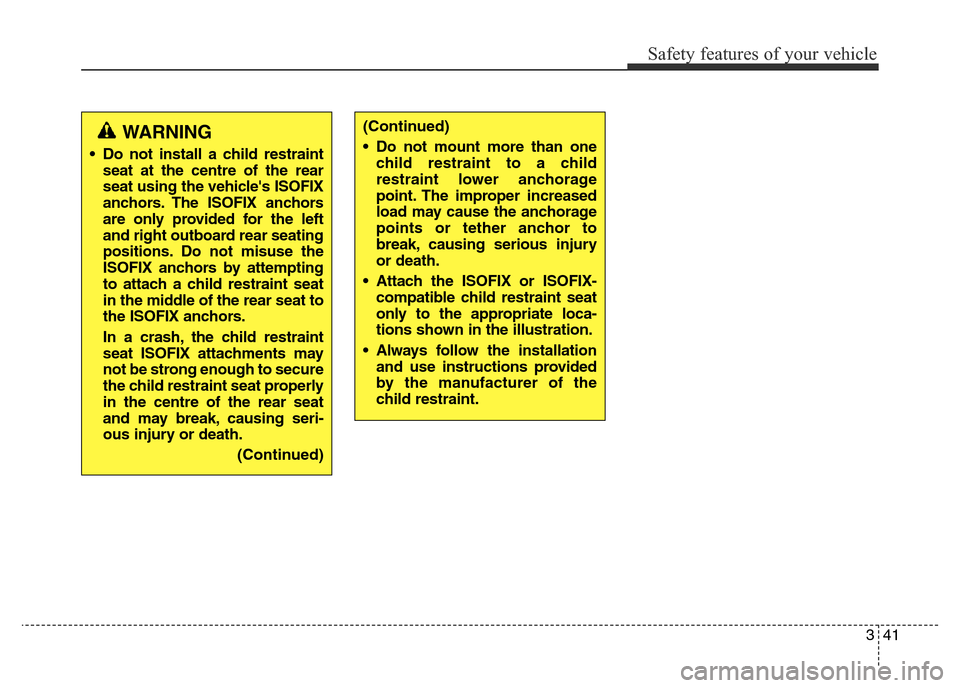Page 51 of 498

333
Safety features of your vehicle
Children travelling in the vehicle
should sit in the rear seat and must
always be properly restrained to min-
imise the risk of injury in an accident,
sudden stop or sudden manoeuvre.
According to accident statistics, chil-
dren are safer when properly
restrained in the rear seats than in
the front seat. Larger children not in
a child restraint should use one of
the seat belts provided.
You should be aware of the specific
requirements in your country. Child
and/or infant safety seats must be
properly placed and installed in the
rear seat. You must use a commer-
cially available child restraint system
that meets the requirements of the
Safety Standards of your country.
Child restraint systems are designed
to be secured in vehicle seats by lap
belts or the lap belt portion of a
lap/shoulder belt, or by a tether
anchor and/or ISOFIX anchors.
Children could be injured or killed in
a crash if their restraints are not
properly secured. For small children
and babies, a child seat or infant seat
must be used.Before buying a particular child
restraint system, make sure it fits
your vehicle seat and seat belts, and
fits your child. Follow all the instruc-
tions provided by the manufacturer
when installing the child restraint
system.
CHILD RESTRAINT SYSTEM
WARNING
• A child restraint system must
be placed in the rear seat.
Never install a child or infant
seat on the front passenger's
seat. Should an accident
occur and cause the passen-
ger-side air bag to deploy, it
could severely injure or kill an
infant or child seated in an
infant or child seat. Thus only
use a child restraint in the
rear seat of your vehicle.
(Continued)
(Continued)
• A seat belt or child restraint
system can become very hot
if it is left in a closed vehicle
on a sunny day, even if the
outside temperature does not
feel hot. Be sure to check the
seat cover and buckles before
placing a child there.
• When the child restraint sys-
tem is not in use, store it in
the cargo area or fasten it with
a seat belt so that it will not be
thrown forward in the case of
a sudden stop or an accident.
• Children may be seriously
injured or killed by an inflating
air bag. All children, even
those too large for child
restraints, must travel in the
rear seat.
Page 57 of 498

339
Safety features of your vehicle
Securing a child restraint system
with “ISOFIX” system and “Tether
Anchorage” system (if equipped)
ISOFIX is a standardised method of
fitting child seats that eliminates the
need to use the standard adult seat
belt to secure the seat in the vehicle.
This enables a much more secure
location with the added benefit of eas-
ier and quicker installation.
An ISOFIX-seat may only be
installed if it has vehicle-specific or
universal approval in accordance
with the requirements of relevant
regulations.
❈ISOFIX: International Standards Origanisation FIX
There are child restraint symbols
located on the lower portion of each
side of the rear seatbacks. These
symbols indicate the position of the
lower anchors for child restraints if
equipped.
Both rear outboard seats are
equipped with a pair of ISOFIX
anchorages as well as a correspon-
ding top tether anchorage on the
back side of the back rest. The
ISOFIX anchorages are located
between seat cushion and back rest,
marked with the ISOFIX icon.
B230D01NF
OMD030022N
ISOFIX AnchorISOFIX Anchor
Position Indicator
WARNING - Child
restraint anchorage
• Child restraint anchorages are
designed to withstand only
those loads imposed by cor-
rectly fitted child restraints.
Under no circumstances are
they to be used for adult seat
belts or harnesses or for
attaching other items or
equipment to the vehicle.
• The tether strap may not work
properly if attached some-
where other than the correct
tether anchor.
Page 58 of 498

Safety features of your vehicle
40 3
For installation, CRS ISOFIX con-
necters have to engage with the
vehicles ISOFIX anchorages (listen
for a CLICK, check potential visual
indicators on the CRS and cross-
check by pulling).
CRS with universal approval to rele-
vant regulations need to be fixed
additionally with a top tether strap
connected to the corresponding top
tether anchorage point in the back
rest.
The installing and the use of a child-
seat has to be done according to the
installing-manual, which is provided
with the ISOFIX-seat.To secure the child restraint seat:
1. To engage the child restraint seat
to the ISOFIX lower anchor, insert
the child restraint seat latch into
the ISOFIX anchor. Listen for the
audible “click” sound.
2. Connect the tether strap hook to
the child restraint hook holder and
tighten to secure the seat. (Refer
to the previous page.)
WARNING
• When using the vehicle's
"ISOFIX" system to install a
child restraint system in the
rear seat, all unused vehicle
rear seat belt metal latch
plates or tabs must be latched
securely in their seat belt
buckles and the seat belt
must be retracted behind the
child restraint to prevent the
child from reaching and tak-
ing hold of unretracted seat
belts. Unlatched metal latch
plates or tabs may allow the
child to reach the unretracted
seat belts which may result in
strangulation and a serious
injury or death to the child in
the child restraint.
• Do not place anything around
the ISOFIX anchors. Also
make sure that the seat belt is
not caught in the ISOFIX
anchors.
CAUTION
Do not allow the rear seat belt to
get scratched or pinched by the
ISOFIX-seat latch and ISOFIX
anchor during the installation.
Page 59 of 498

341
Safety features of your vehicle
WARNING
• Do not install a child restraint
seat at the centre of the rear
seat using the vehicle's ISOFIX
anchors. The ISOFIX anchors
are only provided for the left
and right outboard rear seating
positions. Do not misuse the
ISOFIX anchors by attempting
to attach a child restraint seat
in the middle of the rear seat to
the ISOFIX anchors.
In a crash, the child restraint
seat ISOFIX attachments may
not be strong enough to secure
the child restraint seat properly
in the centre of the rear seat
and may break, causing seri-
ous injury or death.
(Continued)
(Continued)
• Do not mount more than one
child restraint to a child
restraint lower anchorage
point. The improper increased
load may cause the anchorage
points or tether anchor to
break, causing serious injury
or death.
• Attach the ISOFIX or ISOFIX-
compatible child restraint seat
only to the appropriate loca-
tions shown in the illustration.
• Always follow the installation
and use instructions provided
by the manufacturer of the
child restraint.